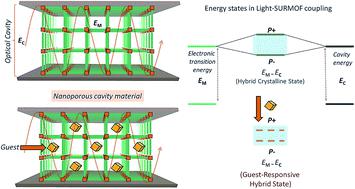当前位置:
X-MOL 学术
›
Chem. Sci.
›
论文详情
Our official English website, www.x-mol.net, welcomes your feedback! (Note: you will need to create a separate account there.)
Guest-responsive polaritons in a porous framework: chromophoric sponges in optical QED cavities
Chemical Science ( IF 8.4 ) Pub Date : 2020-07-13 , DOI: 10.1039/d0sc02436h Ritesh Haldar 1, 2, 3 , Zhihua Fu 1, 2, 3 , Reetu Joseph 1, 3, 4 , David Herrero 5, 6, 7, 8, 9 , Luis Martín-Gomis 5, 6, 7, 8, 9 , Bryce S. Richards 1, 1, 3, 4, 10 , Ian. A. Howard 1, 1, 3, 4, 10 , Angela Sastre-Santos 5, 6, 7, 8, 9 , Christof Wöll 1, 2, 3
Chemical Science ( IF 8.4 ) Pub Date : 2020-07-13 , DOI: 10.1039/d0sc02436h Ritesh Haldar 1, 2, 3 , Zhihua Fu 1, 2, 3 , Reetu Joseph 1, 3, 4 , David Herrero 5, 6, 7, 8, 9 , Luis Martín-Gomis 5, 6, 7, 8, 9 , Bryce S. Richards 1, 1, 3, 4, 10 , Ian. A. Howard 1, 1, 3, 4, 10 , Angela Sastre-Santos 5, 6, 7, 8, 9 , Christof Wöll 1, 2, 3
Affiliation

|
Introducing porous material into optical cavities is a critical step toward the utilization of quantum-electrodynamical (QED) effects for advanced technologies, e.g. in the context of sensing. We demonstrate that crystalline, porous metal–organic frameworks (MOFs) are well suited for the fabrication of optical cavities. In going beyond functionalities offered by other materials, they allow for the reversible loading and release of guest species into and out of optical resonators. For an all-metal mirror-based Fabry–Perot cavity we yield strong coupling (∼21% Rabi splitting). This value is remarkably large, considering that the high porosity of the framework reduces the density of optically active moieties relative to the corresponding bulk structure by ∼60%. Such a strong response of a porous chromophoric scaffold could only be realized by employing silicon-phthalocyanine (SiPc) dyes designed to undergo strong J-aggregation when assembled into a MOF. Integration of the SiPc MOF as active component into the optical microcavity was realized by employing a layer-by-layer method. The new functionality opens up the possibility to reversibly and continuously tune QED devices and to use them as optical sensors.
中文翻译:

多孔框架中的客体响应极化子:光学QED腔中的发色海绵
将多孔材料引入光腔是将量子电动力学(QED)效应用于先进技术的关键一步,例如在感知的背景下。我们证明晶体,多孔金属有机框架(MOF)非常适合制造光学腔。除了超越其他材料提供的功能之外,它们还允许可逆的加载和释放来宾物质进出光谐振器。对于基于全金属镜面的Fabry-Perot腔,我们产生强耦合(〜21%Rabi分裂)。考虑到骨架的高孔隙率使旋光部分的密度相对于相应的本体结构降低了约60%,因此该值非常大。多孔发色支架的如此强的响应只能通过采用设计用于强J的硅酞菁(SiPc)染料来实现-组装到MOF中时的聚合。通过采用逐层方法将作为活性成分的SiPc MOF集成到光学微腔中。新功能使可逆和连续调谐QED设备并将其用作光学传感器的可能性成为可能。
更新日期:2020-08-05
中文翻译:

多孔框架中的客体响应极化子:光学QED腔中的发色海绵
将多孔材料引入光腔是将量子电动力学(QED)效应用于先进技术的关键一步,例如在感知的背景下。我们证明晶体,多孔金属有机框架(MOF)非常适合制造光学腔。除了超越其他材料提供的功能之外,它们还允许可逆的加载和释放来宾物质进出光谐振器。对于基于全金属镜面的Fabry-Perot腔,我们产生强耦合(〜21%Rabi分裂)。考虑到骨架的高孔隙率使旋光部分的密度相对于相应的本体结构降低了约60%,因此该值非常大。多孔发色支架的如此强的响应只能通过采用设计用于强J的硅酞菁(SiPc)染料来实现-组装到MOF中时的聚合。通过采用逐层方法将作为活性成分的SiPc MOF集成到光学微腔中。新功能使可逆和连续调谐QED设备并将其用作光学传感器的可能性成为可能。

























 京公网安备 11010802027423号
京公网安备 11010802027423号